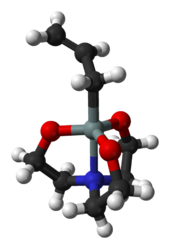Chemistry:Atrane
Atranes are a class of tricyclic molecules with three five-membered rings. It is a heterocyclic structure similar to the propellanes. It has a transannular dative bond from a nitrogen at one bridgehead to a Lewis acidic atom such as silicon or boron at the other bridgehead.[1] The name "atrane" was first proposed by Mikhail Grigorievich Voronkov (ru).[1]
Nomenclature

Various atranes are named depending on the central element, e.g. "silatrane" (E = silicon); "boratrane" (E = boron); "phosphatrane" (E = phosphorus), etc. It is also proposed that when Y = nitrogen, the prefix "aza" be inserted before element + "atrane" (azasilatrane, for example) because atranes wherein E = silicon and Y = oxygen have been referred to as just "silatranes".[2]
Structure and properties
Silatranes exhibit unusual properties as well as biological activity in which the coordination of nitrogen to silane plays an important role. Some derivatives such as phenylsilatrane are highly toxic.
The transannular coordinate bond in atranes can be stretched (quasiatranes) and even broken (proatranes,) by controlling their stereoelectronic properties. The strength of the transannular interaction depends on the electronegativity of the participating atoms and the size of the rings.
thumb|290 px|right|Protonation of [[Verkade base gives an atrane.[3]]] Proazaphosphatrane is a very strong non-ionic base and is utilized in various types of organic synthesis as an efficient catalyst.

See also
References
- ↑ 1.0 1.1 Voronkov, Mikhail G.; Baryshok, Viktor P. "Atranes - a new generation of biologically active substances" (in Russian) Vestnik Rossiiskoi Akademii Nauk 2010, volume 80, 985-992.
- ↑ Verkade, John G. (1994). "Main group atranes: Chemical and structural features". Coordination Chemistry Reviews 137: 233–295. doi:10.1016/0010-8545(94)03007-D.
- ↑ Verkade, John G.; Urgaonkar, Sameer; Verkade, John G.; Urgaonkar, Sameer (2012). "Proazaphosphatrane". Encyclopedia of Reagents for Organic Synthesis. doi:10.1002/047084289X.rn00702.pub2. ISBN 978-0471936237.
- ↑ Chalkley, Matthew J.; Drover, Marcus W.; Peters, Jonas C. (2020). "Catalytic N2-to-NH3 (or -N2H4) Conversion by Well-Defined Molecular Coordination Complexes". Chemical Reviews 120 (12): 5582–5636. doi:10.1021/acs.chemrev.9b00638. PMID 32352271.
 |



